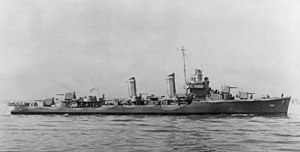
The Mahan-class destroyers of the United States Navy were a series of 18 destroyers of which the first 16 were laid down in 1934. The last two of the 18, Dunlap and Fanning, are sometimes considered a separate ship class. All 18 were commissioned in 1936 and 1937. Mahan was the lead ship, named for Rear Admiral Alfred Thayer Mahan, an influential historian and theorist on sea power.

USS Chauncey (DD-667) was a Fletcher-class destroyer of the United States Navy, the third Navy ship named for Commodore Isaac Chauncey (1779–1840).

USS Chandler (DD-206/DMS-9/AG-108) was a Clemson-class destroyer in the United States Navy. She was the only ship named for William Eaton Chandler, who served as Secretary of the Navy from 1882 to 1886.

USS Abner Read (DD-526) was a Fletcher-class destroyer in the service of the United States Navy, named after Lieutenant Commander Abner Read, who fought in the American Civil War. The ship fought in World War II, seeing action in the Aleutian Islands Campaign and in 1943 she survived hitting a mine that blew off her stern. After repairs, she returned to service and operated in support of Allied forces in the New Guinea campaign and the Battle of Leyte. She was sunk in an air attack off Leyte on 1 November 1944.

USS Phelps (DD-360) was a World War II-era Porter-class destroyer in the service of the United States Navy. She was named for Thomas Stowell Phelps, who was a Rear Admiral in the US Navy in 1884.

USS Kane (DD-235/APD-18) was a Clemson-class destroyer in the United States Navy during World War II. She was the first ship named for Elisha Kent Kane.

USS Burns (DD-588), a Fletcher-class destroyer, was the second ship of the United States Navy to be named for Captain Hugh Otway Burns (1775–1850), a privateer in the War of 1812.

USS Bell (DD-587) was a Fletcher-class destroyer of the United States Navy, the second Navy ship named for Rear Admiral Henry H. Bell (1808–1868).

USS Guest (DD-472), a Fletcher-class destroyer, was a ship of the United States Navy named for Commodore John Guest (1822–1879).

The first USS Dewey (DD-349) was a Farragut-class destroyer of the United States Navy, launched in 1934 and named for Admiral George Dewey. Dewey served in the Pacific through World War II. After escaping damage during the attack on Pearl Harbor, Dewey screened the aircraft carrier USS Lexington until the carrier was lost in the battle of the Coral Sea; then screened USS Saratoga through the invasion of Guadalcanal and the battle of the Eastern Solomons. Following overhaul in San Francisco, Dewey spent 1943 in Alaskan waters supporting the invasions of Attu and Kiska. Dewey spent 1944 supporting raids in the Marshalls, Carolines, and Marianas, including screening carriers during the battle of the Philippine Sea. After being damaged by Typhoon Cobra during the recapture of the Philippines, Dewey supported the invasion of Iwo Jima and spent the remainder of the war screening replenishment oilers.

USS Hull (DD-350) was a Farragut-class destroyer in the United States Navy during World War II. She was named for Isaac Hull.

The third USS Macdonough (DD-351) was a Farragut-class destroyer in the United States Navy during World War II. She was named for Thomas Macdonough.

USS David W. Taylor (DD-551), a Fletcher-class destroyer, was a ship of the United States Navy named for Rear Admiral David W. Taylor (1864–1940).

USS Blue (DD-744), an Allen M. Sumner-class destroyer, was the second United States Navy ship of that name, for Lieutenant Commander John S. Blue (1902–1942).

The second USS Gridley (DD-380) was the lead ship of her class of destroyers in the United States Navy. She was the second US Navy ship named for Charles Vernon Gridley. She served with distinction in the Pacific Theater during the Second World War and shared in the sinking of a Japanese submarine.

USS Bradford (DD-545) was a Fletcher-class destroyer of the United States Navy. She was named for Captain Gamaliel Bradford (1768–1824), a privateer during the Quasi-War with France.

USS Caldwell (DD-605) was a Benson-class destroyer in the United States Navy during World War II. She was named for James R. Caldwell.

USS Coghlan (DD-606) was a Benson-class destroyer in the United States Navy during World War II. She was the second ship named for Joseph Bulloch Coghlan.

USS Frazier (DD-607) was a Benson-class destroyer in the United States Navy during World War II.

USS Riddle (DE-185) was a Cannon-class destroyer escort in service with the United States Navy from 1943 to 1946. In 1950, she was transferred to France where she served as Kabyle (F718) until being decommissioned and scrapped in 1959.




















